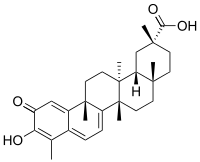Celastrol
 | |
| Names | |
|---|---|
| IUPAC name
3-Hydroxy-9β,13α-dimethyl-2-oxo-24,25,26-trinoroleana-1(10),3,5,7-tetraen-29-oic acid | |
| Other names
Tripterine | |
| Identifiers | |
| 3D model (JSmol) |
|
| ChemSpider | |
| ECHA InfoCard | 100.164.266 |
| PubChem CID |
|
| |
| |
| Properties | |
| C29H38O4 | |
| Molar mass | 450.62 g·mol−1 |
| Appearance | Crystalline solid |
| Melting point | 213 °C (415 °F; 486 K)[1] |
| Except where otherwise noted, data are given for materials in their standard state (at 25 °C [77 °F], 100 kPa). | |
| Infobox references | |
Celastrol (tripterine) is a chemical compound isolated from the root extracts of Tripterygium wilfordii (Thunder god vine) and Celastrus regelii. Celastrol is a pentacyclic triterpenoid and belongs to the family of quinone methides.
In in vitro and in vivo animal experiments, celastrol exhibits antioxidant,[2] anti-inflammatory,[3][4] anticancer,[5][6][7][8] and insecticidal [9] activities. It has been shown to have obesity-controlling effects in mice.[10] Celastrol has also shown to possess (by inhibition of NF-κB in the hypothalamus[11]) anti-diabetic effects on diabetic nephropathy and improve whole-body insulin resistance[12][13]
References
- ↑ Ryu, Y. B.; Park, S. J.; Kim, Y. M.; Lee, J. Y.; Seo, W. D.; Chang, J. S.; Park, K. H.; Rho, M. C.; Lee, W. S. (2010). "SARS-CoV 3CLpro inhibitory effects of quinone-methide triterpenes from Tripterygium regelii". Bioorganic & Medicinal Chemistry Letters. 20 (6): 1873. PMID 20167482. doi:10.1016/j.bmcl.2010.01.152.
- ↑ Allison, A. C.; Cacabelos, R.; Lombardi, V. R. M.; Alvarez, X. A.; Vigo, C. (2001). "Celastrol, a potent antioxidant and anti-inflammatory drug, as a possible treatment for Alzheimer's disease". Progress in Neuro-Psychopharmacology and Biological Psychiatry. 25 (7): 1341–1357. PMID 11513350. doi:10.1016/S0278-5846(01)00192-0.
- ↑ Kim, D. H.; Shin, E. K.; Kim, Y. H.; Lee, B. W.; Jun, J. -G.; Park, J. H. Y.; Kim, J. -K. (2009). "Suppression of inflammatory responses by celastrol, a quinone methide triterpenoid isolated from Celastrus regelii". European Journal of Clinical Investigation. 39 (9): 819–827. PMID 19549173. doi:10.1111/j.1365-2362.2009.02186.x.
- ↑ Venkatesha, S. H.; Yu, H.; Rajaiah, R.; Tong, L.; Moudgil, K. D. (2011). "Celastrus-derived Celastrol Suppresses Autoimmune Arthritis by Modulating Antigen-induced Cellular and Humoral Effector Responses". Journal of Biological Chemistry. 286 (17): 15138–15146. PMC 3083183
 . PMID 21402700. doi:10.1074/jbc.M111.226365.
. PMID 21402700. doi:10.1074/jbc.M111.226365. - ↑ Lee, J. H.; Choi, K. J.; Seo, W. D.; Jang, S. Y.; Kim, M.; Lee, B. W.; Kim, J. Y.; Kang, S.; Park, K. H.; Lee, Y. S.; Bae, S. (2011). "Enhancement of radiation sensitivity in lung cancer cells by celastrol is mediated by inhibition of Hsp90". International Journal of Molecular Medicine. 27 (3): 441–6. PMID 21249311. doi:10.3892/ijmm.2011.601.
- ↑ Tiedemann, R. E.; Schmidt, J.; Keats, J. J.; Shi, C. -X.; Zhu, Y. X.; Palmer, S. E.; Mao, X.; Schimmer, A. D.; Stewart, A. K. (2008). "Identification of a potent natural triterpenoid inhibitor of proteosome chymotrypsin-like activity and NF- B with antimyeloma activity in vitro and in vivo". Blood. 113 (17): 4027–4037. PMC 3952546
 . PMID 19096011. doi:10.1182/blood-2008-09-179796.
. PMID 19096011. doi:10.1182/blood-2008-09-179796. - ↑ Zhu, H.; Liu, X. -W.; Cai, T. -Y.; Cao, J.; Tu, C. -X.; Lu, W.; He, Q. -J.; Yang, B. (2010). "Celastrol Acts as a Potent Antimetastatic Agent Targeting 1 Integrin and Inhibiting Cell-Extracellular Matrix Adhesion, in Part via the p38 Mitogen-Activated Protein Kinase Pathway". Journal of Pharmacology and Experimental Therapeutics. 334 (2): 489–499. PMID 20472666. doi:10.1124/jpet.110.165654.
- ↑ Byun, J. -Y.; Kim, M. -J.; Eum, D. -Y.; Yoon, C. -H.; Seo, W. -D.; Park, K. H.; Hyun, J. -W.; Lee, Y. -S.; Lee, J. -S.; Yoon, M. -Y.; Lee, S. -J. (2009). "Reactive Oxygen Species-Dependent Activation of Bax and Poly(ADP-ribose) Polymerase-1 is Required for Mitochondrial Cell Death Induced by Triterpenoid Pristimerin in Human Cervical Cancer Cells". Molecular Pharmacology. 76 (4): 734–744. PMID 19574249. doi:10.1124/mol.109.056259.
- ↑ Avilla, J. S.; Teixidò, A.; Velázquez, C.; Alvarenga, N.; Ferro, E.; Canela, R. (2000). "Insecticidal Activity of Maytenus Species (Celastraceae) Nortriterpene Quinone Methides against Codling Moth, Cydia pomonella (L.) (Lepidoptera: Tortricidae)". Journal of Agricultural and Food Chemistry. 48 (1): 88–92. PMID 10637057. doi:10.1021/jf990008w.
- ↑ Liu, Junli; Lee, Jaemin; Salazar Hernandez, Mario Andres; Mazitschek, Ralph; Ozcan, Umut (May 2015). "Treatment of Obesity with Celastrol". Cell. 161 (5): 999–1011. doi:10.1016/j.cell.2015.05.011.
- ↑ Lee, J. H., Koo, T. H., Yoon, H., Jung, H. S., Jin, H. Z., Lee, K., ... & Lee, J. J. (2006). Inhibition of NF-κB activation through targeting IκB kinase by celastrol, a quinone methide triterpenoid. Biochemical pharmacology, 72(10), 1311-1321. doi:10.1016/j.bcp.2006.08.014
- ↑ Kim, J. E.; Lee, M. H.; Nam, D. H.; Song, H. K.; Kang, Y. S.; Lee, J. E.; Han, K. H. (2013). "Celastrol, an NF-κB inhibitor, improves insulin resistance and attenuates renal injury in db/db mice". PLOS ONE. 8 (4): e62068. doi:10.1371/journal.pone.0062068.
- ↑ Abu Bakar, M. H.; Cheng, K. K.; Sarmidi, M. R.; Yaakob, H.; Huri, H. Z. (2015). "Celastrol Protects against Antimycin A-Induced Insulin Resistance in Human Skeletal Muscle Cells". Molecules. 20 (5): 8242–8269. doi:10.3390/molecules20058242.
This article is issued from
Wikipedia.
The text is licensed under Creative Commons - Attribution - Sharealike.
Additional terms may apply for the media files.